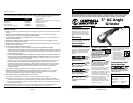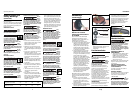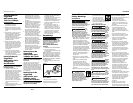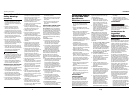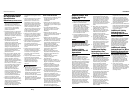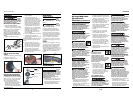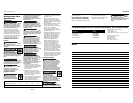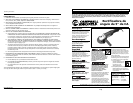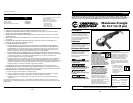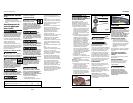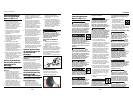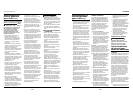
• La velocidad nominal del accesorio
debe ser por lo menos igual a la
velocidad máxima indicada en la
herramienta eléctrica. Los accesorios
que funcionen a una velocidad
superior a la velocidad nominal
pueden desprenderse.
• El diámetro exterior y el espesor del
accesorio deben estar dentro de la
capacidad nominal de la herramienta
eléctrica. Los accesorios de tamaño
inadecuado no pueden controlarse o
equiparse con protección
adecuadamente.
• El tamaño del eje de ruedas, bridas,
almohadillas de soporte o de
cualquier otro accesorio debe
ajustarse adecuadamente al vástago
de la herramienta eléctrica. Los
accesorios cuyo orificio para el
vástago no se ajusta la pieza de
montaje de la herramienta eléctrica
pierden la estabilidad, vibran
excesivamente y pueden causar la
pérdida del control.
• No use un accesorio dañado. Antes
de cualquier uso, verifique que el
accesorio no esté astillado o rajado,
que la almohadilla de soporte no
presente rajaduras, quiebres o
desgaste excesivo, que el cepillo de
alambre no tenga alambres sueltos o
partidos. Si se deja caer la
herramienta o el accesorio, verifique
que no presente daños o instale un
accesorio sin daños. Después de
revisar e instalar un accesorio,
ubíquese usted mismo y los
observadores fuera del plan de
rotación del accesorio y haga
funcionar la herramienta eléctrica a
la velocidad máxima y sin carga por
un minuto. Normalmente los
accesorios dañados se desprenden
durante este tiempo de prueba.
• Mantenga a los observadores a una
distancia segura del área de trabajo.
Toda persona que ingrese al área de
trabajo debe usar equipo de
protección personal. Un accesorio
dañado o fragmentos de la pieza de
trabajo pueden desprenderse y
causar lesiones en el área
inmediatamente contigua al área de
trabajo.
• Cuando esté efectuando un trabajo
por el cual el accesorio de corte
puede entrar en contacto con un
cable eléctrico oculto o su propio
cable, sujete la herramienta eléctrica
sólo por las superficies de sujeción
aisladas. Los accesorios de corte que
entran en contacto con un cable
“bajo tensión” pueden poner “bajo
tensión” las partes metálicas de la
herramienta eléctrica y causar un
choque eléctrico al operador.
• Coloque el cordón eléctrico lejos de
los accesorios en rotación. Si pierde
el control, el cordón puede cortarse
o quedar apretado y su mano o
brazo puede ser halado contra el
accesorio en rotación.
• Nunca suelte la herramienta antes de
que el accesorio se haya detenido
por completo. El accesorio en
rotación puede asirse a la superficie y
halar la herramienta fuera de
control.
• No haga funcionar la herramienta
mientras la transporta a su lado.
El contacto accidental del accesorio
en rotación con su ropa puede
envolverla y halar la herramienta
contra su cuerpo.
• Limpie con regularidad los orificios
de ventilación de la herramienta
eléctrica. El ventilador del motor trae
polvo dentro de la caja y la
acumulación excesiva de polvo
metálico puede causar riegos
eléctricos.
• Desconecte el enchufe de la fuente
de corriente antes de hacer
cualquier ajuste, cambiar accesorios
o guardar la herramienta. Dichas
medidas de seguridad preventivas
reducen el riesgo de que la
herramienta se active por accidente.
• Esta herramienta NO debe
modificarse ni usarse para cualquier
aplicación que no sea la aplicación
para la cual fue diseñada.
PRECAUCIONES DE SEGURIDAD
PARA LA RECTIFICADORA
• Controle que la velocidad que marca
la rueda sea igual o mayor a la
velocidad nominal de la
rectificadora.
• Asegúrese de que las dimensiones
de la rueda sean compatibles con la
rectificadora y que la rueda se ajuste
al vástago.
• Las ruedas abrasivas deberán
guardarse y tratarse con cuidado,
siguiendo las instrucciones del
fabricante.
• Asegúrese de que las ruedas
y puntas montadas estén calzadas de
acuerdo con las instrucciones del
fabricante.
• Asegúrese de que el producto
abrasivo esté correctamente armado
y ajustado antes de usar y ponga la
herramienta en funcionamiento sin
carga durante 30 segundos en una
posición segura; deténgala
inmediatamente si observa una
vibración considerable o si detecta
otros defectos. Si esto ocurre,
inspeccione la máquina para
determinar la causa.
• No use casquillos reductores ni
adaptadores independientes para
adaptar las ruedas abrasivas con
orificios grandes.
• Asegúrese de que la pieza de
trabajo esté apoyada
adecuadamente.
• Asegúrese de que las chispas no
generen un peligro, es decir, que no
lleguen a las personas ni enciendan
sustancias inflamables.
• Siempre use gafas protectoras de
seguridad y protectores auditivos.
Use otros equipos de seguridad
personal como guantes, delantal
y casco siempre que sea necesario.
• La rueda abrasiva debe estar
conectada en forma segura antes de
conectar la rectificadora a una
fuente de electricidad. No ajuste en
exceso ya que esto puede provocar
grietas en la rueda abrasiva.
• Las ruedas abrasivas deben estar
libres de irregularidades y grietas.
Antes de usar, haga una prueba del
funcionamiento normal con la rueda
abrasiva apuntando hacia una
dirección segura, lejos de las
personas o los objetos. Las grietas
Manual de Instrucciones
Información General
de Seguridad sobre
Herramientas
Eléctricas (Continuacion)
20 Sp
5
DG470800CK
www.chpower.com
the sanding project. Vacuum filter
bags should be changed frequently.
2. Plastic drop cloths should be
gathered up and disposed of along
with any dust chips or other
removal debris. They should be
placed in sealed refuse receptacles
and disposed of through regular
trash pick-up procedures. During
clean up, children and pregnant
women should be kept away from
the immediate work area.
3. All toys, washable furniture and
utensils used by children should be
washed thoroughly before being
used again.
SERVICE
Have
your
power tool serviced by a qualified
repair person using only identical
replacement parts. This will ensure that
the safety of the power tool is main-
tained.
Further Safety
Instructions For All
Operations
Kickback And Related
Warnings
Kickback is a sudden reaction to a
pinched or snagged rotating wheel,
backing pad, brush or any other
accessory. Pinching or snagging causes
rapid stalling of the rotating accessory
which in turn causes the uncontrolled
power tool to be forced in the
direction opposite of the accessory’s
rotation at the point of the binding.
For example, if an abrasive wheel is
snagged or pinched by the workpiece,
the edge of the wheel that is entering
into the pinch point can dig into the
surface of the material causing the
wheel to climb out or kick out. The
wheel may either jump toward or away
from the operator, depending on
direction of the wheel’s movement at
the point of pinching. Abrasive wheels
may also break under these conditions.
Kickback is the result of power tool
misuse and/or incorrect operating
procedures or conditions and can be
avoided by taking proper precautions
as given below.
1. Maintain a firm grip on the power
tool and position your body and
arm to allow you to resist kickback
forces. Always use auxiliary handle,
if provided, for maximum control
over kickback or torque reaction
during start-up. The operator can
control torque reactions or kickback
forces, if proper precautions are
taken.
2. Never place your hand near the
rotating accessory. Accessory may
kickback over your hand.
3. Do not position your body in the
area where power tool will move if
kickback occurs. Kickback will
propel the tool in direction
opposite to the wheel’s movement
at the point of snagging.
4. Use special care when working
corners, sharp edges etc. Avoid
bouncing and snagging the
accessory. Corners, sharp edges or
bouncing have a tendency to snag
the rotating accessory and cause
loss of control or kickback.
5. Do not attach a saw chain
woodcarving blade or toothed saw
blade. Such blades create frequent
kickback and loss of control.
Additional Safety
Instructions For
Grinding Operations
SAFETY WARNINGS SPECIFIC FOR
GRINDING OPERATIONS:
1. Always use guard designed for the
type of wheel you are using. The
guard must be securely attached to
the power tool and positioned for
maximum safety, so the least
amount of wheel is exposed
towards the operator. The guard
helps to protect operator from
broken wheel fragments and
accidental contact with wheel.
2. Use only wheel types that are
recommended for your power tool
and the specific guard designed for
the selected wheel. Wheels for
which the power tool was not
designed cannot be adequately
guarded and are unsafe.
3. Wheels must be used only for
recommended applications. For
example: do not grind with the
side of cut-off wheel. Abrasive cut-
off wheels are intended for
peripheral grinding, side forces
applied to these wheels may cause
them to shatter.
4. Always use undamaged wheel
flanges that are of correct size and
shape for your selected wheel.
Proper wheel flanges support the
wheel thus reducing the possibility
of wheel breakage. Flanges for cut-
off wheels may be different from
grinding wheel flanges.
5. Do not use worn down wheels from
larger power tools. Wheel intended
for larger power tool is not suitable
for the higher speed of a smaller
tool and may burst.
Additional Safety
Instructions For
Sanding Operations
SAFETY WARNINGS SPECIFIC FOR
SANDING OPERATIONS:
When sanding, do not use excessively
oversized sanding disc paper. Follow
manufacturers recommendations,
when selecting sanding paper. Larger
sanding paper extending beyond the
sanding pad presents a laceration
hazard and may cause snagging,
tearing of the disc, or kickback.
Additional Safety
Instructions For Wire
Brushing Operations
SAFETY WARNINGS SPECIFIC FOR
WIRE BRUSHING OPERATIONS:
1. Be aware that wire bristles are
thrown by the brush even during
ordinary operation. Do not
overstress the wires by applying
excessive load to the brush. The
wire bristles can easily penetrate
light clothing and/or skin.
2. If the use of a guard is
recommended for wire brushing, do
not allow any interference of the
wire wheel or brush with the guard.
Wire wheel or brush may expand in
diameter due to work load and
centrifugal forces.
General Power Tool
Safety Warnings
(Continued)



